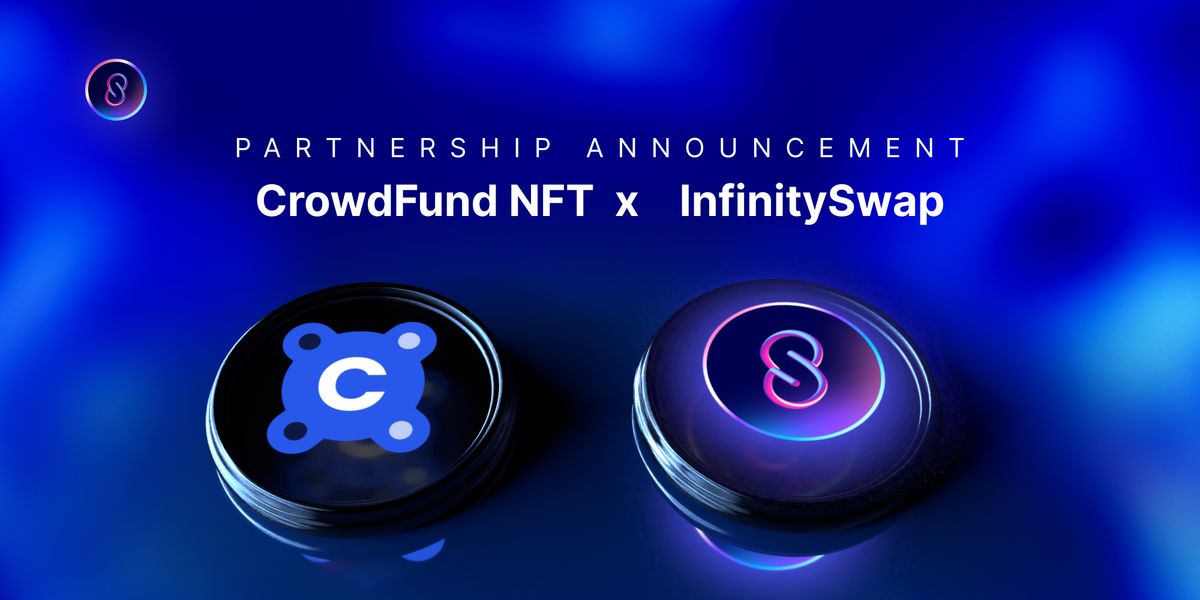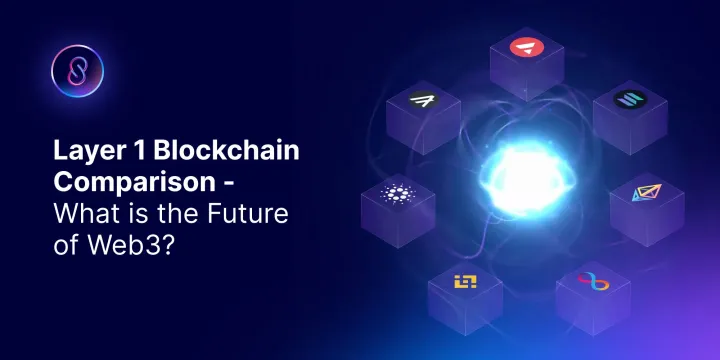InfinitySwap Forms a Strategic Partnership with CrowdFund NFT
InfinitySwap and CrowdFund NFT have announced our intention to collaborate on a variety of different levels in order to further the development of the Internet Computer ecosystem.

InfinitySwap and CrowdFund NFT have announced our intention to collaborate on a variety of different levels in order to further the development of the Internet Computer ecosystem.
We are delighted that CrowdFund NFT has successfully integrated the Infinity wallet and we will be working on future crowdfunding projects with InfinitySwap utilizing the burgeoning platform for a variety of reasons.
CrowdFund NFT: an alternative to traditional crowdfunding platforms
CrowdFund NFT is an alternative to Kickstarter, Go Fund Me, and other traditional crowdfunding platforms. Its unique approach? It runs entirely on the Internet Computer blockchain and uses NFTs to provide backers with ‘proof of ownership in the projects they help crowdfund. This has many beneficial applications in a new rewards-based crowdfunding model.

It is no secret that the NFT space is booming. 2021 has seen the market grow by 1,785% — but so far, this has come only from applying NFTs to the artwork industry— with very few other applications of NFTs seeing other real-world utility.
There are a few exceptions. The ORIGYN foundation has raised $20 million dollars, at a $300 million valuation, for applying NFTs to luxury goods. In essence, a Rolex watch, Moncler coat, or Louis Vuitton handbag would come with an NFT. Why? To provide proof of ownership and authenticity to buyers.
This understanding of what an NFT is aligns with the view at CrowdFund NFT, where the benefits of non-fungible tokens go far beyond artwork since they have the capacity to provide ownership status, and authenticity, to holders. This has the potential to change how we manage ownership across all industries. For instance, passports could be NFTs, season tickets to football clubs could be NFTs, and buying a house could come with an NFT — all because you can be reliably identified as an owner.
CrowdFund NFT want to apply this model to the CrowdFunding space. To understand how this works, it is important to know about the two different kinds of crowdfunding: equity and rewards-based crowdfunding.
Equity-based crowdfunding
When it comes to equity-based crowdfunding, the advantages of an NFT model come primarily from the fact that it makes buying and selling equity easy. If a backer participates in a crowdfunding round, they can become an equity holder without much contractual luggage, simply by receiving an NFT in exchange for their investment.
Not only does this make it easy for backers to become equity holders, but when they decide to sell that equity, the NFT can simply be transferred to a new buyer through a blockchain transaction! This only works because NFTs are stored on the blockchain and thus cannot be tampered with, hacked, or duplicated. It is possible to know who owns the NFT at any given point in time and to know that it is unique. However, to make it work, we have to redefine the meaning of an equity contract — by making the contract not with the original buyer as a person but with whoever the NFT holder is at a given point in time.
There are also benefits to this model for project creators. As a project creator, if you decide to sell 2% of your equity for a crowdfunding round, then that 2% can get sold on through secondary NFT marketplaces — without further diluting equity but simply increasing its value. Because blockchain transactions can happen instantly, immutably and at scale, it is conceivable to see that value increase rapidly through multiple sales of the NFTs, which in this scenario represent equity.
There are some concerns with this model. The most obvious is that without crypto KYC, it is difficult to know who owns the equity, despite knowing where the NFT is held because most wallets are anonymous. This can be a problem for creators because they may need to know who owns equity in their company for administrative purposes. Traditional equity-based crowdfunding platforms have also faced this problem, and there are a few ways around it.
The first solution has been used by many traditional crowdfunding platforms before — and it involves making use of a Special Purpose Vehicle, or ‘SPV.’ This is a legal entity governed by one or more identifiable persons who represent crowdfunding round equity holders. In the CrowdFund NFT use case, NFT holders would be represented by an SPV when it comes to administrative actions or decisions within the larger company.
The second solution comes from a wider improvement in blockchain technology, namely — proof of personhood. This is something that the DFINITY Foundation, which is the primary contributor to the Internet Computer, is actively working on. It essentially allows people to become identifiable on the blockchain if they choose to do so. You could fill your wallet with your personal information, and this would be authenticated through “people parties,” run by the Dfinity Foundation. You would not be able to have proof of personhood for multiple wallets, just one. For anyone who knows about the history of blockchain, proof of personhood is a complex problem, but if cracked, it can help solve an immense amount of issues relating to KYC. The feature is set to launch in 2022 on the Internet Computer. This is one of the many reasons CrowdFund NFT has chosen to build on this specific blockchain.
Despite the many benefits of applying NFTs to equity crowdfunding — equity-based crowdfunding is a regulated industry in most jurisdictions. A license is often required, and regulators have yet to catch up with the intricacies of blockchain technology. This makes it difficult to imagine starting with equity-based crowdfunding. Instead, to begin there is a simpler kind of crowdfunding and one that is unregulated. This is rewards-based or donation-based crowdfunding.
Rewards based crowdfunding
When we think of traditional rewards-based crowdfunding, we often associate it with physical objects: backers receive a t-shirt, a cool hat, or a skateboard. This is what most projects offer as their rewards: some form of tangible return for participation in a crowdfunding round. This can be managed with NFTs, but it is not where the NFT model provides its unique benefit. Where NFTs add value is through the kinds of rewards we can see being adopted in the NFT space already.
Currently, there are many NFT projects that provide rewards to their holders. If you own a CryptoPunk, you may be invited to special parties or receive early access to other NFT releases. It serves as a membership token to a crypto community. This is the kind of perk CrowdFund NFT intends to encourage and expects to see grow in the crowdfunding space under the NFT model.
CrowdFund NFT wants to see holders get access to long-term perks. They could receive early access to new products, permanent membership status for a club invites to events, and more. Intangible rewards are difficult to track through current crowdfunding processes — where the only proof of participation is a receipt to the crowdfunding round, paid for by a specific person.
In the NFT model, just like for equity-based crowdfunding — it is easy to transfer rewards to someone else. Simply sell the NFT to a new holder through the blockchain. Once again, the contractual agreement is between project creators and NFT holders — not between project creators and a specific person. It is easy to imagine how access to these rewards can increase in value rapidly, as the NFTs can be sold on secondary marketplaces instantly and at scale.
CrowdFund NFT wants to discourage project creators from providing physical rewards because they cannot be passed on easily and because they don’t provide long-term value. Instead, buying a membership to a club that has particular perks is a far more valuable kind of reward — which the NFT model enables.
How does CrowdFund NFT work?
When a fundraiser wants to participate in a crowdfunding round, they have to transfer ICP tokens into an escroc wallet, owned and managed by CrowdFund NFT. The reason for this is that projects do not receive any funds until they meet their funding goal.
If a project does not meet its goal in the specified timeframe, crowd funders are reimbursed — they have only lost the transaction fee, which on the Internet Computer is extremely cheap (only 0.001 ICP flat fee per transaction). The Internet Computer runs on a reverse gas model and as such, does not use gas fees, which you see on blockchains like Ethereum. This makes transactions cheap and reimbursements possible.
If a project does meet its funding goal, then funds are released from the CrowdFund NFT escroc wallet into the project creator’s wallet. Similarly, NFTs are delivered to investor wallets.
Projects receive their funds, and project backers have proof of their participation in the crowdfunding round. The NFTs serve as a legal obligation for project creators to provide the promised rewards to backers.
There is no risk of skullduggeryfrom CrowdFund NFT Because the entire process is governed by smart contracts, meaning it is entirely automated and cannot be subject to tampering from the CrowdFund NFT team.
Kickstarter’s announcement — moving to the Blockchain & why CrowdFund NFT is different
Kickstarter has recently announced that they are shifting their platform onto the blockchain. You can read about their recent move here:
The Future of Crowdfunding Creative Projects
Kickstarter are announcing their commitment to a more open, collaborative, and decentralized future. As a first step, they're…
www.kickstarter.com
This is a good move. Crowdfunding definitely belongs on the blockchain. However, they have decided to build their own protocol and their own token. CrowdFund NFT believe that this is the wrong approach.
Kickstarter states:
“In the spirit of decentralization, we’re establishing an independent organization that will kick off the development of the protocol”.
In essence, they are trying to become their own blockchain — where people can buy Kickstarter tokens and trade them on the platform to help fund projects.
This does not change the crowdfunding model — it just creates a currency for Kickstarter to grow. Investors in projects will not receive anything different from what they are already receiving for their participation in a crowdfunding round, the only difference is that they will have to use Kickstarter tokens to invest in projects.
CrowdFund NFT do not believe that creating a crowdfunding token is necessary, nor is it helpful. There are plenty of tokens that serve as currencies and plenty of protocols that provide decentralized platform capabilities. The Internet Computer is run by the Internet Computer Protocol (ICP), where token holders can vote for the addition or removal of any features of the blockchain.
From an economic standpoint, the move from Kickstarter is obvious — they are trying to create a token that will almost certainly be worth billions instantly. One also doesn’t doubt that they will hold a significant percentage of the tokens' circulating supply. However, they are not changing how crowdfunding works. Investors will back projects with money and receive a t-shirt, or a mug. CrowdFund NFT want them to receive indisputable access to long-term perks or equity through NFTs, which they can trade and exchange with anyone.
It gives backers long-term proof of ownership and project creators can see the value of their perks or equity increase rapidly through NFT trades.
CrowdFund NFT can also beat competitors to market share — the roadmap:
The platform is set to see its first project go live in March 2022. CrowdFund NFT want to provide crowdfunding rounds to 34 projects in 2022, and grow rapidly in 2023.
Because Kickstarter intends to build its own protocol, we are at least a year and half to two years away from seeing them launch on the Blockchain. If CrowdFund NFT can get there first, and establish the NFT model as the leading way to perform crowdfunding on the blockchain, then they can win a huge share this large and rapidly growing market.
We wish our new partner every success in the endeavors and will be happy to utilize the platform for future crowdfunding projects.
Connect with InfinitySwap
Twitter | Website | Telegram | Discord | Github
Connect with CrowdFund NFT






Comments ()